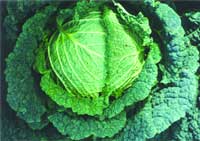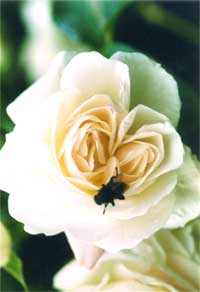Positive Health Online
Your Country

Health Benefits of Horticultural Therapy
by Marilyn Mountford(more info)
listed in herbal medicine, originally published in issue 65 - June 2001
So what is this? Could this be the ultimate in fads? Where you the gardener send plants to a therapist to bloom? Actually the reverse is the truth. One school quantifies it for the human patient as 'A curative form of treatment involving the art and science of growing'.
But what does this mean to you the client? A horticultural therapist is trained to assess your needs, taking into account both your physical and mental state. Combined with knowledge of your interests, the therapist works with you to provide a sustained programme of appropriate projects and support. This plan will be looking to provide the client with a focus for improved fitness and health and to introduce balance where previously chaos was to be found.
Finding the correct instruction programme in this therapy is not easy, as it is so new in its current concept. My own training was through a distance learning course. The focus here is structured to cover the following:
- Related topics of anatomy;
- Equipment and tools;
- Garden health and safety;
- Helping patients to design different types of gardens to suit their needs;
- Different methods of relaxation;
- Houseplant propagation;
- The wide range of complementary therapies.
A Short History
I feel that in America the benefits of horticultural therapy are better known than in the UK. In 1768, Benjamin Rush considered that digging in the soil had a curative effect on the mentally ill, and by 1806 Spanish hospitals were also advocating this form of treatment. By 1879, we have the first case of a greenhouse being built by the Pennsylvania Friends Asylum for the Insane for their residents. During the Second World War, American garden club volunteers brought the joys of gardening to the wounded soldiers. The first undergraduate degree was awarded from Michigan State University in 1955. So from this we can see how the therapy has naturally evolved as it gained in credibility over the years.[1]
Here, and in America, the better-known variety of the therapy is practised in an institutional environment with therapists working alongside rehabilitation and therapy teams. The types of problems that benefit from this treatment are substance abusers, mental or physical disabilities, sensory impairments and geriatric problems.
On their website, the American Horticultural Therapy Association – www.ahta.org lists the advantages that can be brought to the patient:
- Enhancing self-esteem;
- Alleviating depression;
- Improving motor skills;
- Providing opportunities in problem solving;
- Encouraging work adjustment;
- Improving social interaction and communication;
- Teaching marketable horticultural and business skills.
They conclude, "For many patients whose conditions (and treatments) have rendered them feeling passive and dependent, having living plants to nurture creates a role reversal. Horticultural Therapy places the patient in the care giving role and this often engenders confidence and a renewed sense of purpose."[2]
Gardens and gardening have been around since the days of the Bible. Here the benefits were simple – food to eat and herbs to flavour and to act as a cure for a miscellany of health problems. Every century has its problems and challenges to be met, but I think the pressures of the 20th/21st century have met an increase in stress-related disorders.
It would be easy to dismiss the value of the trained therapist and argue, "Well of course anyone can do that! What about the weekend gardener or the allotment owner?" Yes, of course there are thousands of people who can testify to the joys of digging the soil and being proud of their horticultural knowledge. Gardening is one of the main leisure activities of our time. In America, for example, gardening is the number one outdoor leisure time activity with more than 84% of all households participating. The influx worldwide of DIY centres, videos, books and gardens open to the public all testify to the pleasure this subject can provide.
In the UK, the gardening profile was raised firstly by radio with programmes like 'Gardener's Question Time' and latterly by all the television programmes, which regularly bring to our homes the 'horticultural heroes'. They make the makeovers or the scientific problems experienced seem so easy – "Well if they can do it, so can we" becomes the subliminal message.
An interest then naturally begs information – catalogue collecting becomes addictive. Going to the library, or using the Internet or even visiting public gardens to find out how they have coped with a particular problem (for example a difficult local soil) are all different ways to learn more. Looking after plants (whatever the stage) is a forward-looking positive step in the therapeutic process. As with many creative crafts, it is never just a case of doing one thing – the bug hits and the thirst for knowledge begins.
The Many Benefits of Gardening
This interest encourages a beneficial positive mental attitude. Consider the sheer act of hope that is required to plan and plant a garden. Gardening is a creative art form dealing with many skills both practical and artistic. So many have found that deep pleasure can be provided and enjoyed with the evolving of a plot of land to a place of beauty. The style is not important, it is the personal pleasure that it creates. This sense of inner well-being influences our health and the way we are perceived.

The natural beauty of a cabbage
Continuing on the gardening theme, relaxation comes with an appreciation of nature through the use of the senses. Here four out of the five senses (sight, touch, hearing and smell) would come into their element. Taste would only safely come into effect with, for example, the enjoyment of home-grown fruit and vegetables. We all know the wonder and joy felt picking a lovely ripe tomato from the vine and biting into its succulent texture. So fruit or vegetable growing might very well be something to consider if your garden is big enough.
Could this sort of gardening be expanded to the creation of a place of solitude, a small piece of the garden that contains all the necessary ingredients for peace and harmony – scented flowers, a bench and perhaps a water feature? Contemplate sitting on a warm summer's evening with the gentle buzzing of the bees, the evocative sounds of the gurgling of water combined with the perfume of roses and lavender, whilst reading your favourite book. I imagine the soft gentle colours of the garden, nothing vibrant – shades of green, mauves and pinks with a touch of pale cream. Sounds blissful, if you compare it to the strident pressure of modern day living.
What about the gentle art of potpourri making? Something that can be enjoyed throughout the year, as you collect your materials to dry and then create wonderful scented bowls both to decorate and perfume your home. There are many books on the subject outlining the specific methods involved and suggested recipes but one I have enjoyed very much is Potpourris and Other Fragrant Delights by Jacqueline Heriteau.[3]
But of course there are many other choices of gardening projects that could be considered – building raised beds for disabled gardeners, finding a particular style of garden that is of interest and creating it in your own – perhaps Mediterranean? What about the historical side of gardening – plants and tools that were favourites all those years ago? The Chelsea Physic Garden (by Chelsea Embankment, London) might be able to help you here or the Museum of Garden History, London, by Lambeth Bridge. Consider too, the Lost Gardens of Heligan in Cornwall where so much has been done to revive the art of Victorian gardening.

Taking allotment growing seriously
How to Proceed
Self-help or working with a therapist on a one-to-one basis in an informal way works for many too. So what areas would you be looking to cover? Firstly, the medical assessment and secondly the interests of the patient and how the two combined could be utilized to form a focused programme that would inspire, encourage and produce the desired result.
Whether using self-help or the support of a qualified therapist, notes would have to be made to identify the problem areas and then to focus on the interests. I always encourage the keeping of a diary to chart progress. Progress noted down illustrates the goals and pitfalls of the project that have been overcome and of course the successes! (If writing is a problem then a tape diary could be kept.) A wall chart might also be useful to indicate the start and completion of any scheme and the list of tasks that have to be undertaken to complete the project.
My tutor, Ann, told the wonderfully positive tale of the lady living in a tower block completely overwhelmed by the problems of her life; so depressed that she was unable to perform daily commonplace tasks, such as washing a cup. The flat was in total chaos, so Ann set her the task of going out, choosing one plant and bringing it back to the flat. This was achieved and a red flowering geranium was duly bought and placed amongst all this mess. Gradually, the flowers had the desired effect as the patient began to feel that the beauty of the plant demanded a better and more aesthetic environment in which to flourish. So gradually, little by little, the flat was cleared up and she began to live again – all because she had something to focus on outside her immediate problems.

A place of Beauty
Linking alternative medicine with this type of therapy would seem appropriate too. Depending upon the needs of the patient, one might suggest considering any of the following: homeopathy, acupuncture, osteopathy, nutritional therapy and of course aromatherapy – to name but a few. I hasten to add not necessarily in a self-help fashion but by seeking out qualified practitioners who would work in conjunction with the horticultural therapy to maximize the healing process. A gentle form of meditation could also be taught to encourage relaxation in daily life. Some books to consider here would be Nature's Way: The Complete Guide to Natural Healing Therapies[4] and Natural Born Healers.[5]
As horticultural therapy works for everyone, garden or no garden, what other sorts of projects would the therapist propose or could you pursue if you had no garden? One of the most obvious is flower arranging, as bought flowers can be used. Joining your local National Association of Flower Arranging Clubs would provide you with the means of learning all about flowers (whether fresh or dried) and at the same time meeting new people.
If you are good with your hands then there are so many opportunities: making presents with dried flowers, sewing lavender bags, or even stamping your own gift-wrap paper. An interesting book to read here would be All You Need to Know About Rubber Stamping.[6] (Your therapist would be able to work with you to help encourage you to find the most appropriate projects for you to undertake). Photography is a wonderful option as it not only gives you the chance to visit amazing gardens but provides an ongoing interest that can be shared with friends on the Internet, made up into cards or specialized photograph albums created to provide gifts or lasting memories. Even improving on your childhood painting skills could lead to hours of pleasure whether through going to classes or painting outdoors in your own garden – the options are endless.
This approach sums up the whole concept of horticultural therapy. There is so much to explore whatever your ability or interest. I hope you find that the challenge works for you.
References
1. Relf Diane. Horticulture: A Therapeutic Tool. J Rehab. 39(1): 27-29.
2. The American Horticultural Therapy Association (AHTA) website address is www.ahta.org
3. Heriteau Jacqueline. Potpourris and Other Fragrant Delights. Simon & Schuster. 1973.
4. Evans Mark. Nature's Way: The Complete Guide to Natural Healing Therapies. Southwater. 2000.
5. Wilson Elisabeth and Lewith George. Natural Born Healers. Collins & Brown. 1997.
6. Wright Maggie. All You Need to Know About Rubber Stamping. Search Press. 1994.



Comments:
-
No Article Comments available